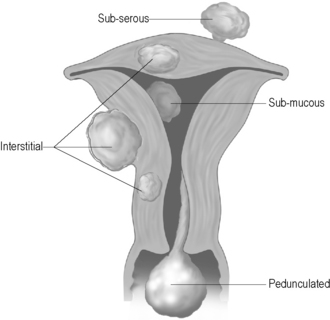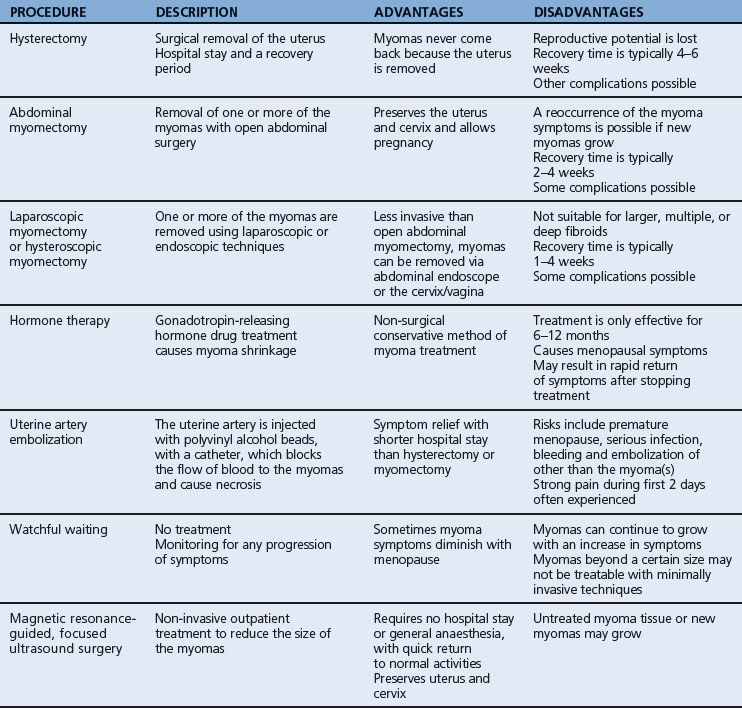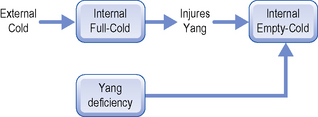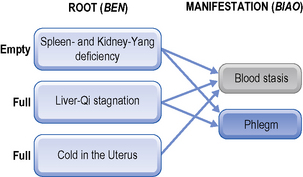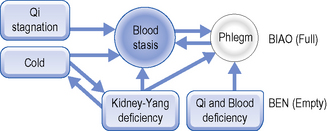Chapter 67 Myoma
Myomas (or ‘fibroids’) are very common benign uterine tumours in women.
Western medicine view
Description
There are several types of myomas differentiated according to their location (Fig. 67.1):
Clinical manifestations
The main clinical manifestations are as follows:
The treatment options for myomas are detailed in Table 67.1.
Chinese medicine view
In Chinese medicine, myomas are a type of ‘Abdominal Masses’ (in women called Zheng Jia) which were discussed in Chapter 60. ‘Abdominal Masses’ are called Ji Ju. Ji indicates actual abdominal masses which are immovable; if there is an associated pain, its location is fixed. These masses are due to stasis of Blood. Ju indicates abdominal masses which come and go, do not have a fixed location and are movable; if there is an associated pain, it too comes and goes and changes location. Such masses are due to stagnation of Qi. Actual abdominal tumours therefore pertain to the category of Abdominal Masses and specifically Ji masses, i.e. Blood masses.
Aetiology
External Cold
External Cold is a frequent cause of abdominal masses in women. During puberty, after childbirth and during every period, the Uterus is particularly vulnerable to invasions of external Cold: external Cold generates internal Cold and this leads to Blood stasis. Blood stasis, in turn, may lead to the formation of masses. As discussed in Chapter 65, endometriosis may also be considered a form of abdominal masses and external Cold plays a role also in its aetiology.
Pathology
Internal Cold (that develops from invasion of external Cold) is a Full condition: this is manifested by a Full-Tight pulse and a Pale tongue with thick, white coating, signs of Full-Cold. Internal Cold, however, may also arise from a deficiency of Spleen- and Kidney-Yang, in which case it is Empty-Cold. It should be noted that Empty-Cold may also develop from Full-Cold: this happens when the retention of Full-Cold injures Yang and this, in turn, leads to Empty-Cold. Thus the Full-Cold is transformed into Empty-Cold (Fig. 67.2).
Apart from Blood stasis, some types of myomas may be due to a combination of Blood stasis with Phlegm: when this is the case, the myoma (if palpable) feels relatively softer than one from Blood stasis (Fig. 67.3). Figure 67.4 summarizes the pathology of myomas and highlights the interactions among the various aspects of the Root and Manifestation.
Treatment principle
Before discussing the treatment principle, it is important to discuss the question of Bian Bing, i.e. identifying the Chinese disease corresponding to myoma. Two investigations are usually carried out when diagnosing a patient. The first is Bian Bing i.e. identifying to which Chinese medicine ‘disease’ the patient’s disharmony pertains to. As one of the main symptoms of myoma is heavy menstrual bleeding, one of the Chinese diseases it may correspond to is Flooding and Trickling (Beng Lou) which was discussed in Chapter 17
Stay updated, free articles. Join our Telegram channel

Full access? Get Clinical Tree


